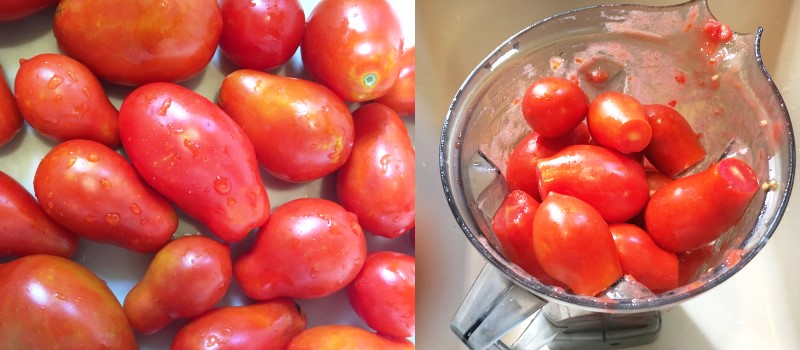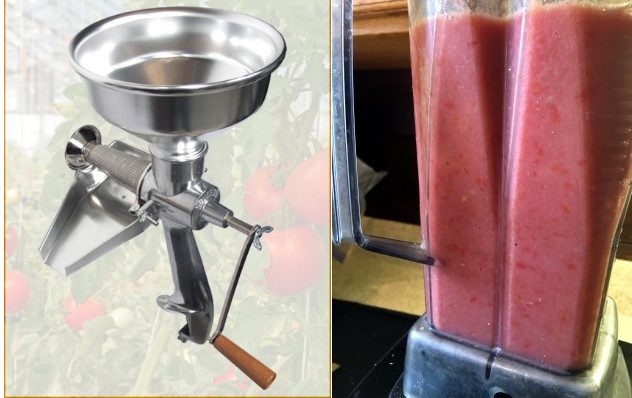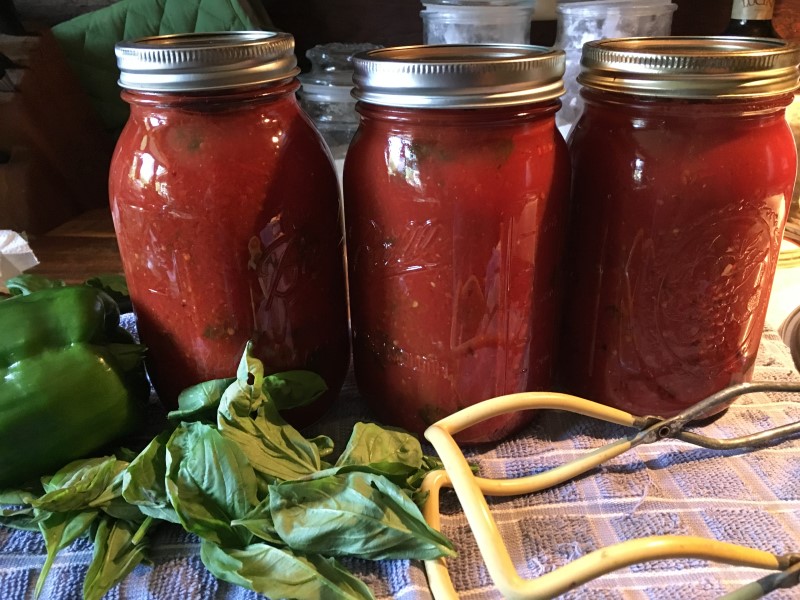In late summer, gardening is very much about reaping the harvest and preserving it for winter. Nothing brings this home more than a shelf full of bright, red, canned tomatoes. Tomatoes are one of the easiest and safest foods to preserve by canning because their high acid content inhibits the growth of harmful bacteria like botulism. I try to preserve about 20-30 quarts of whole tomatoes, and when this is accomplished I will use the rest of my harvest for tomato sauce.
Canning Tomato Sauce Basic Instructions
Pear shaped Roma’s are preferred for tomato sauce because they are primarily flesh, with much less water than your standard “eaters.” It takes much less time or energy to cook them down to a nice, thick sauce.

I simply cut off the tops where the stem was attached and puree in a blender. Sauce purists will utilize a device known as a “Squeezo,” which separates the seeds and skins from the pulp. It can also be used for seeded grapes if you are into making grape jelly. The Original Squeezo sells directly from the company.

Pour the pureed tomatoes in a large pot and cook until the sauce reaches the desired consistency, nice and thick. Depending on how much water is in your tomatoes, this may take several hours.
As the sauce gets thick, and is about ready to can, you can add flavoring and spices like basil and oregano. You do not want to add these too early, as the flavor will just evaporate or boil away. Salt to taste.
You may want to add some vegetable flavorings like onion, garlic, and green pepper. You can also include chunks of zucchini, but as I mentioned last month, you must add these in limited quantity to maintain the high acid levels that inhibit the germination of botulism, which can only develop into the botulism toxin in low acid, oxygen-free environments such as vacuum sealed canning jars.
Sterilize your jars in boiling water. Remove the jars from the water. Pour the sauce in your canning jars. You’ll find tools/accessories like a jar lifter and canning funnel will come in very handy.
TIP: Use a paper towel to make sure there are no drops of juice or bits of tomato on the rim of the jar, which can prevent your jar lid from sealing properly. Your jar lids should be in your boiling water for a few minutes to soften the rubber gasket that establishes the seal. Place the lid on each jar, secure in place with a jar ring, and return to the pot with boiling water.

When you preserve food in a boiling water-bath canning pot, you heat the jars and their contents to the boiling point, again you are killing off the micro-organisms that can cause spoilage, mold, or fermentation, and bacteria such as botulism. Boil for 20-25 minutes. Remove from the boiling water. As the jars cool, they will pull a vacuum You will hear a “ping” as each lid inverts and forms the seal. Check each jar by pressing down in the center of each lid. There should be no movement. Finally remove the ring. Write the date on the top of each lid, so that months or even years later, you will know exactly how long ago you canned the contents.

NOTE: The USDA recommends adding citric acid or vinegar to your canned tomatoes to insure they have the proper acidity to fend off bacteria!
An attentive reader hipped me to some new (for me) information regarding home canning of tomatoes. Apparently tomatoes today are not as acidic as those from past decades – either that or the USDA is just being more cautious – and it is now recommended that you add an acidic substance such as lemon juice, vinegar or citric acid to your home-canned tomato products.
From the USDA: Acidification: To ensure safe acidity in whole, crushed, or juiced tomatoes, add 2 tablespoons of bottled lemon juice or 1/2 teaspoon of citric acid per quart of tomatoes. For pints, use 1 tablespoon bottled lemon juice or 1/4 teaspoon citric acid. Acid can be added directly to the jars before filling with product. Add sugar to offset acid taste, if desired. Four tablespoons of a 5 percent acidity vinegar per quart may be used instead of lemon juice or citric acid. However, vinegar may cause undesirable flavor changes.
Two tablespoons of lemon juice or four tablespoons of vinegar per quart! That has got to change the flavor, making it necessary (for me) to add some sugar. I will have to wait until next year to try it out. In the meantime…You have been forewarned!



